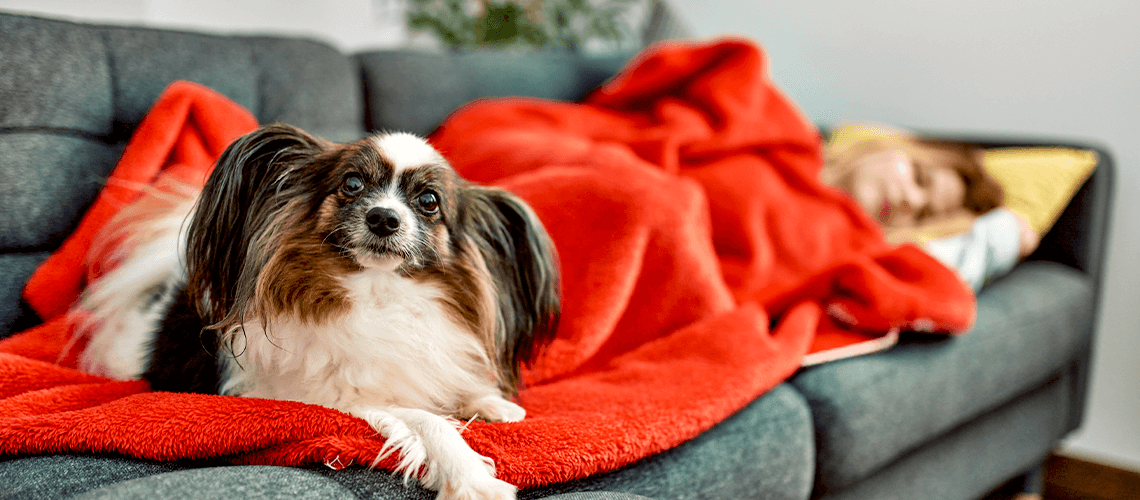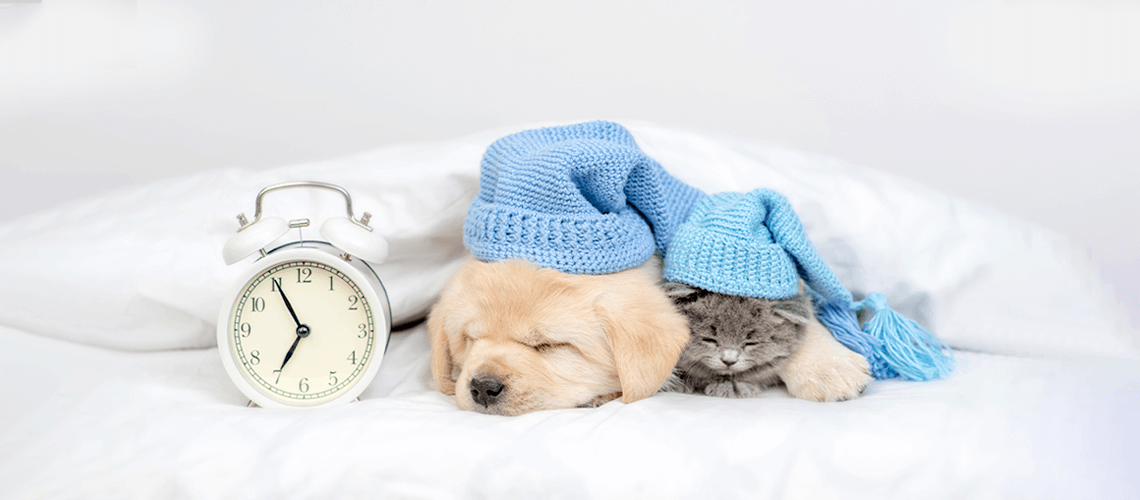Who doesn’t dread losing an hour of sleep? Unfortunately, daylight savings time can also be a nightmare for our furry friends. As we prepare to lose an hour of restful sleep, remember our furry family members will also need a reset! A disruption in their daily routine can lead to some unexpected difficulties. We’ve got everything you need to know about how daylight savings time affects your pet and what you can do to help them adjust.
How daylight savings time affects your pet’s daily routine
Can we change our clocks again to adjust for daylight savings? How does this affect our beloved pets? As pet owners, we know well that animals can be creatures of habit. When we turn back time, it can throw off their schedules! Consider it: cats usually have sleeping, eating, and playing routines. As for dogs, all of their walks change with the time shift. You might have to adjust meals or activities an hour later or earlier. If not taken into account, it could leave your pet feeling a bit confused! Fortunately, there are many practical solutions to help pets re-adjust their daily routines. With some love and patience, your furry friend will soon thrive again!
Tips for helping your pet adjust to the time change
The time change can be challenging for everyone, including our four-legged friends. To help your pet adjust to the new schedule, start small. Make sure to give them plenty of playtimes before the sun sets to tire them out, and move their bedtime earlier than you’re used to, even if it’s just slightly earlier each day. Pets, like humans, have an internal clock called the circadian rhythm, which regulates their sleep-wake cycle. Moving your pet’s bedtime forward by an hour for daylight savings can disrupt their circadian rhythm and cause difficulty falling asleep or waking up at the new time.
To help your pet adjust to the time change, it’s best to gradually shift their bedtime by 10-15 minutes each day leading up to daylight savings. For example, if your pet’s bedtime is 8 pm, you could start moving it forward by 10-15 minutes each day, four days before the time change. By daylight savings, your pet’s bedtime will gradually shift forward by an hour, and they should adjust more quickly to the new schedule.
After daylight savings, you can use the same gradual approach to shift your pet’s bedtime back to its original time. Start by moving their bedtime back by 10-15 minutes each day until they return to their regular schedule. Maintaining a consistent schedule for feeding, exercise, and playtime is also essential, as this can help regulate your pet’s circadian rhythm and promote better sleep.
Adjusting your pet’s feeding schedule is also essential; feed them twenty minutes earlier each day as you ease into the new time. Lastly, make sure to give them plenty of quality cuddle time throughout the transition – they need it too! With consistency and patience, your furry family member will soon accept the new schedule in no time.

Why some pets may not be affected by daylight savings time at all
Most animals don’t even have the mental capacity to understand the concept of time, let alone Daylight Savings Time. They are unaffected by the ‘extra hour’ we seem to gain or lose either in spring or fall because they simply continue their natural routine – sleep when they want and arise when instinct (and perhaps their owners) permits. For those pets who rely on good old-fashioned human calendars and timetables, extra caution must be taken to avoid any confusion or disruption, as adjustments could be necessary. After all, no matter how smart your pet is, it probably won’t understand why you suddenly can’t make its walk at that same 8 am that it holds so dear!
Just like humans, pets have individual differences in their circadian rhythms and ability to adjust to changes in their sleep schedule. Some pets may be more sensitive to changes in their routine and may have a more challenging time adapting to daylight savings time than others.
Factors affecting how a pet responds to daylight savings time include age, breed, health, and personality. For example, older pets may have a more established sleep schedule and a more challenging time adjusting to changes in their routine, while younger pets may be more adaptable. Breeds that are more active or have higher energy levels may be more affected by changes in their routine, while more laid-back breeds may be less affected.
Additionally, pets already experiencing stress or anxiety may have a more challenging time adjusting to changes in their routine. It’s essential to monitor your pet’s behavior and adjust their routine to ensure they are comfortable and well-rested.
How to tell if your pet is having trouble adjusting to the new schedule
The new schedule might display several tell-tale signs if your pet has been thrown off course. They may be extra clingy, sleeping and eating more than usual, or having accidents around the house. For cats, you may see them hiding away more often or getting involved in mischief when they shouldn’t be. Dogs may become territorial or bark more often at anything – from the mail carrier to a leaf blowing in the wind outside! If your pet is showing these behaviors, you should observe their daily routines to see if there are any changes and make an adjustment as soon as possible so your furry family member can get back on track!
What to do if your pet seems stressed or anxious after the time change
Shifting time twice a year is always challenging, especially if you have a pet! Animals are susceptible to changes in their environment and routine, so that they might become stressed or anxious after the time change. An excellent place to start is to ensure your pet has plenty of activities to stimulate them mentally. Spend extra time playing their favorite game with them or switch up their toy routine for something new. You should also make sure you adjust their bedtime and meal schedule accordingly with the time change so they can get back in the groove of things nicely and easily. If your pet displays signs of anxiety, like hiding or scratching furniture, try aromatherapy products blended with natural essential oils such as lavender to help calm pets. First, research if your pet has any allergies to these treatments. And make sure the product you are using is safe for pets. Talk to your vet about other options that might help ease their stress or anxiety.
As daylight savings time approaches, it’s important to remember that it can be a challenging experience for our furry companions. You and your pet can navigate this adventure together with enough preparation, patience, and understanding. Monitor their behavior and take things at their pace – your pet will appreciate your understanding. Whether or not your pet becomes anxious about the change, transitioning them smoothly is worth the effort and will ultimately benefit their overall well-being.
You can do many things to make this transition easier for your pet. For example, consider doubling up on walks or playing different games of fetch with your pup. Providing your cat with plenty of opportunities for exercise and play during the day can also help them expend energy and sleep more soundly at night, regardless of the time change. And, of course, always remember that every pet deserves love and affection, regardless of the day and time.
So, while losing an hour of sleep may be difficult for both you and your furry friend, try to take advantage of this extra hour and enjoy some quality bonding time with your devoted companion. With extra care and attention, you can help your pet adjust to the time change and ensure they continue to feel loved and supported throughout the process.




